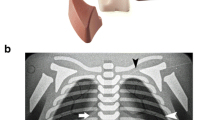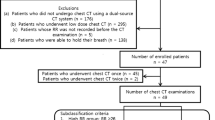Abstract
Objectives
Accurate collimation helps to reduce unnecessary irradiation and improves radiographic image quality, which is especially important in the radiosensitive paediatric population. For AP/PA chest radiographs in children, a minimal field size (MinFS) from "just above the lung apices" to "T12/L1" with age-dependent tolerance is suggested by the 1996 European Commission (EC) guidelines, which were examined qualitatively and quantitatively at a paediatric radiology division.
Methods
Five hundred ninety-eight unprocessed chest X-rays (45 % boys, 55 % girls; mean age 3.9 years, range 0–18 years) were analysed with a self-developed tool. Qualitative standards were assessed based on the EC guidelines, as well as the overexposed field size and needlessly irradiated tissue compared to the MinFS.
Results
While qualitative guideline recommendations were satisfied, mean overexposure of +45.1 ± 18.9 % (range +10.2 % to +107.9 %) and tissue overexposure of +33.3 ± 13.3 % were found. Only 4 % (26/598) of the examined X-rays completely fulfilled the EC guidelines.
Conclusions
This study presents a new chest radiography quality control tool which allows assessment of field sizes, distances, overexposures and quality parameters based on the EC guidelines. Utilising this tool, we detected inadequate field sizes, inspiration depths, and patient positioning. Furthermore, some debatable EC guideline aspects were revealed.
Key Points
• European Guidelines on X-ray quality recommend exposed field sizes for common examinations.
• The major failing in paediatric radiographic imaging techniques is inappropriate field size.
• Optimal handling of radiographic units can reduce radiation exposure to paediatric patients.
• Constant quality control helps ensure optimal chest radiographic image acquisition in children.






Similar content being viewed by others
Abbreviations
- ACR:
-
American College of Radiology
- AEA:
-
Actual exposed area
- AP:
-
Anteroposterior
- DICOM:
-
Digital Imaging and Communications in Medicine
- DR:
-
Digital radiography
- EC:
-
European Commission
- FFD:
-
Film focus distance
- ICC:
-
Intraclass correlation coefficient
- ICRP:
-
International Commission on Radiological Protection
- MaxFS:
-
Maximal field size
- MinFS:
-
Minimal field size
- PA:
-
Posteroanterior
- SD:
-
Standard deviation
- WHO:
-
World Health Organisation
References
International Atomic Energy Agency (2001) Proceedings of an international conference held in Málaga, Spain, 26–30 March 2001, International Conference on Radiological Protection of Patients in Diagnostic and Interventional Radiology, Nuclear Medicine and Radiotherapy. IAEA, Malaga, p 165
Joarde R, Crundwell N, Joarder R (2009) Chest x-ray in clinical practice [Ebook], 1st edn. Springer, London
Don S, Macdougall R, Strauss K et al (2013) Image gently campaign back to basics initiative: ten steps to help manage radiation dose in pediatric digital radiography. AJR Am J Roentgenol 200:W431–W436
Moore QT, Don S, Goske MJ et al (2012) Image gently: using exposure indicators to improve pediatric digital radiography. Radiol Technol 84:93–99
European Commission (1996) European Guidelines on Quality Criteria for Diagnostic Radiographic Images in Paediatrics. ECSC-EC-EAEC, Brussels
Khong PL, Ringertz H, Donoghue V et al (2013) ICRP publication 121: Radiological protection in paediatric diagnostic and interventional radiology. Ann ICRP 42:1–63
Willis CE, Slovis TL (2005) The ALARA concept in pediatric CR and DR: dose reduction in pediatric radiographic exams–a white paper conference. AJR Am J Roentgenol 184:373–374
Amis ES Jr, Butler PF (2010) ACR white paper on radiation dose in medicine: three years later. J Am Coll Radiol 7:865–870
Amis ES Jr, Butler PF, Applegate KE et al (2007) American College of Radiology white paper on radiation dose in medicine. J Am Coll Radiol 4:272–284
Herrmann TL, Fauber TL, Gill J et al (2012) Best practices in digital radiography. Radiol Technol 84:83–89
American College of Radiology (ACR), Society for Pediatric Radiology (SPR) (2011) ACR–SPR Practice Guideline for the Performance of Pediatric and Adult Chest Radiography. American College of Radiology, Reston, p 5
Sandström S, Ostensen H, Pettersson H, Åkerman K, World Health Organization., International Society of Radiology (2003) Radiographic Technique and Projections. In: Ostensen H, Pettersson H (eds) The WHO manual of diagnostic imaging. World Health Organization (WHO) and International Society of Radiology (ISR), Geneva, p 135
European Commission (1996) European Guidelines on Quality Criteria for Diagnostic Radiographic Images. ECSC-EC-EAEC, Brussels
Brennan PC, Johnston D (2002) Irish X-ray departments demonstrate varying levels of adherence to European guidelines on good radiographic technique. Br J Radiol 75:243–248
Grewal RK, Young N, Colins L, Karunnaratne N, Sabharwal N (2012) Digital chest radiography image quality assessment with dose reduction. Australas Phys Eng Sci Med 35:71–80
Muhogora WE, Nyanda AM, Kazema RR (2001) Experiences with the European guidelines on quality criteria for radiographic images in Tanzania. J Appl Clin Med Phys 2:219–226
Goske MJ, Charkot E, Herrmann T et al (2011) Image Gently: challenges for radiologic technologists when performing digital radiography in children. Pediatr Radiol 41:611–619
Kostova-Lefterova D, Taseva D, Ingilizova K, Hristova-Popova J, Vassileva J (2011) Potential for optimisation of paediatric chest X-ray examination. Radiat Prot Dosim 147:168–170
Gogos KA, Yakoumakis EN, Tsalafoutas IA, Makri TK (2003) Radiation dose considerations in common paediatric X-ray examinations. Pediatr Radiol 33:236–240
Oppelt B (2010) Pediatric radiology for medical-technical radiology assistants/radiologists, 1st edn. Thieme, Stuttgart
Suliman II, Elawed SO (2013) Radiation dose measurements for optimisation of chest X-ray examinations of children in general radiography hospitals. Radiat Prot Dosim 156:310–314
Bly R, Jarvinen H, Korpela MH, Tenkanen-Rautakoski P, Makinen A (2011) Estimated collective effective dose to the population from X-ray and nuclear medicine examinations in Finland. Radiat Prot Dosim 147:233–236
Teles P, Carmen de Sousa M, Paulo G et al (2013) Estimation of the collective dose in the Portuguese population due to medical procedures in 2010. Radiat Prot Dosim 154:446–458
Zenone F, Aimonetto S, Catuzzo P et al (2012) Effective dose delivered by conventional radiology to Aosta Valley population between 2002 and 2009. Br J Radiol 85:e330–e338
Williams K, Thomson D, Seto I et al (2012) Standard 6: age groups for pediatric trials. Pediatrics 129:S153–S160
NICHD (2015) Guidance for Clinical Researchers: Harmonizing Pediatric Terminology. Eunice Kennedy Shriver National Institute of Child Health and Human Development (NICHD), Bethesda, MD. Available via https://www.nichd.nih.gov/health/clinicalresearch/clinical-researchers/terminology/Pages/index.aspx accessed 02-02-2015
ÖNORM national (2008) ÖNORM S 5240–8: Sicherung der Bildqualität in röntgendiagnostischen Betrieben - Teil 8: Konstanzprüfung an medizinischen Röntgen-Projektionsradiographie-Einrichtungen mit digitalen Bildempfängersystemen. ÖNORM, Vienna
Hobbs DL (2007) Chest radiography for radiologic technologists. Radiol Technol 78:494–516
Schindelin J, Arganda-Carreras I, Frise E et al (2012) Fiji: an open-source platform for biological-image analysis. Nat Methods 9:676–682
Faul F, Erdfelder E, Buchner A, Lang A-G (2009) Statistical power analyses using G*Power 3.1: Tests for correlation and regression analyses. Behav Res Methods 41:1149–1160
Faul F, Erdfelder E, Lang AG, Buchner A (2007) G*Power 3: a flexible statistical power analysis program for the social, behavioral, and biomedical sciences. Behav Res Methods 39:175–191
Alexander M (2012) Managing patient stress in pediatric radiology. Radiol Technol 83:549–560
Yoo S-J, MacDonald C, Babyn PS (2010) Chest radiographic interpretation in pediatric cardiac patients, 1st edn. Thieme, New York, p 317
Bontrager KL (2001) Textbook of radiographic positioning and related anatomy, 5th edn. Mosby, St. Louis
Hardy M, Boynes S (2003) Paediatric radiography. Blackwell Science, Oxford
Bramson RT, Griscom NT, Cleveland RH (2005) Interpretation of chest radiographs in infants with cough and fever. Radiology 236:22–29
Bomer J, Wiersma-Deijl L, Holscher HC (2013) Electronic collimation and radiation protection in paediatric digital radiography: revival of the silver lining. Insights Imaging 4:723–727
Fauber TL, Dempsey MC (2013) X-ray field size and patient dosimetry. Radiol Technol 85:155–161
Hawking NG, Sharp TD (2013) Decreasing radiation exposure on pediatric portable chest radiographs. Radiol Technol 85:9–16
Akhtar W, Aslam M, Ali A, Mirza K, Ahmad N (2008) Film retakes in digital and conventional radiography. J Coll Physicians Surg Pak 18:151–153
Polunin N, Lim TA, Tan KP (1998) Reduction in retake rates and radiation dosage through computed radiography. Ann Acad Med Singap 27:805–807
American College of Radiology (ACR), Society for Pediatric Radiology (SPR) (2011) ACR–SPR Practice Parameter for the Performance of Portable (Mobile Unit) Chest Radiography. American College of Radiology, Reston, p 7
Grummer-Strawn LM, Reinold C, Krebs NF, (CDC) CfDCaP (2010) Use of World Health Organization and CDC growth charts for children aged 0–59 months in the United States. MMWR Recomm Rep 59:1–15
Soboleski D, Theriault C, Acker A, Dagnone V, Manson D (2006) Unnecessary irradiation to non-thoracic structures during pediatric chest radiography. Pediatr Radiol 36:22–25
Alt CD, Engelmann D, Schenk JP, Troeger J (2006) Quality control of thoracic X-rays in children in diagnostic centers with and without pediatric-radiologic competence. Röfo 178:191–199
Engelmann D, Dutting T, Wunsch R, Troger J (2001) Quality of ambulatory thoracic radiography in the child–a pilot study. Radiologe 41:442–446
Billinger J, Nowotny R, Homolka P (2010) Diagnostic reference levels in pediatric radiology in Austria. Eur Radiol 20:1572–1579
Acknowledgments
The scientific guarantor of this publication is Prof. Dr. Erich Sorantin. The authors of this manuscript declare no relationships with any companies whose products or services may be related to the subject matter of the article. The authors state that this work has not received any funding. One of the authors (Prof. Dr. Erich Sorantin) has significant statistical expertise. Institutional review board approval was obtained. Written informed consent was waived by the institutional review board. Methodology: retrospective, performed at one institution.
Author information
Authors and Affiliations
Corresponding author
Rights and permissions
About this article
Cite this article
Tschauner, S., Marterer, R., Gübitz, M. et al. European Guidelines for AP/PA chest X-rays: routinely satisfiable in a paediatric radiology division?. Eur Radiol 26, 495–505 (2016). https://doi.org/10.1007/s00330-015-3836-7
Received:
Revised:
Accepted:
Published:
Issue Date:
DOI: https://doi.org/10.1007/s00330-015-3836-7




